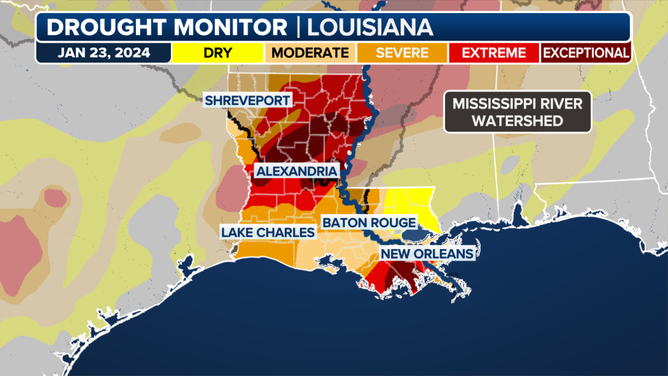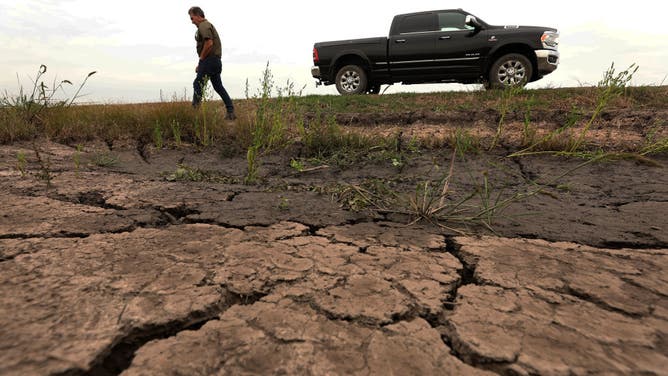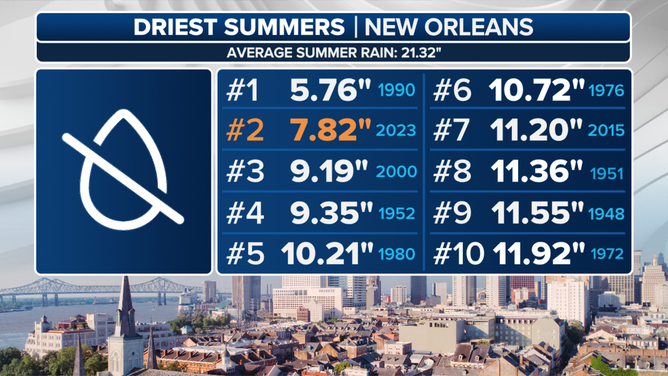Louisiana's drought is fueling the ‘unprecedented’ crawfish prices this season
Prices over $13 a pound are causing the Louisiana staple to become unaffordable. Crawfish app co-founder Laney King said the Mississippi River saltwater intrusion and overall drought have put crawfish farmers in a bind.
Price of crawfish sky-high
FOX Weather's Brandy Campbell hit New Orleans to order up crawfish and take a look into why prices are so high.
NEW ORLEANS – Louisiana's ongoing exceptional drought is making the Bayou state's staple of boiled crawfish unaffordable for many.
Louisiana is amid its worst drought since 2000, with more than 70% of the Bayou State in exceptional drought, the worst rating on the 5-level U.S. Drought Monitor scale. Many of the crawfish farmers' crops from last spring didn't survive without rain.

The latest drought monitor report for Louisiana.
(FOX Weather)
At the beginning of crawfish season in January, a pound of boiled crawfish is going for more than $13 a pound, according to Laney King, co-founder of the Crawfish app.
The app is similar to "Gas Buddy," but for crawfish, it tracks live and boiled crawfish prices across 16,000 businesses and restaurants.
"It's been an unprecedented year. I’ve never seen anything like this," said King, who co-founded the Crawfish app with her husband, Ryan King.
The Kings have lived in Louisiana their whole lives, where crawfish is not just a meal but a must for any celebration.
According to the Louisiana Department of Wildlife and Fisheries, the industry contributes $300 million to Louisiana's economy from the 100 to 120 million pounds of crawfish produced there.
"We have two seasons, football season and crawfish season," King said.
In January 2020, boiled crawfish went for $4.99 a pound, according to Crawfish app numbers. King said 2020, during the coronavirus pandemic, "was an incredible year for crawfish" because the supply was high.
In January 2023, prices were up to $6.04 a pound. People were complaining in 2023 about how expensive that was, but 2024 takes the cake at $13 a pound, according to King.
"It’s unaffordable," King said. For a family boil, you need at least a three-pound tray.

Farmer Chad Hanks walks by dry cracked earth on his farm where he usually grows crawfish on October 10, 2023 in Kaplan, Louisiana. As exceptional drought grips southern Louisiana, farmers are starting to harvest the state's 500,000 acres of sugarcane and are expecting a 30 to 35 percent decline in crop yields. (Photo by Justin Sullivan/Getty Images)
(Getty Images)
The problem for crawfish farmers began over the summer.
New Orleans experienced its second-driest summer on record in 2023 with 7.82 inches of rain. An average summer rain season brings over 21 inches. It was also the hottest summer since 1946, with an average temperature of 86.9 degrees from June to August.
The drought has not improved during the fall and winter months. Only 3% of Louisiana faced extreme and exceptional drought three months ago. Now, nearly 90% of the state is facing the worst drought conditions.
NEW ORLEANS NO LONGER UNDER CURRENT THREAT OF SALTWATER INTRUSION FROM MISSISSIPPI RIVER
Multiple freshwater sources supply wild crawfish in Louisiana, including the rivers, bayous, swamps and lakes of the Atchafalaya and Vermilion-Teche basins. All suffered from drought this year. However, most of the state’s crawfish are produced by more than 1,300 crawfish farmers who need rainwater for their ponds.

New Orleans's driest summers on record.
(FOX Weather)
"We knew it was going to be interesting when we weren’t getting any rain this summer," King said.
Farmers turned to well water to supplement, but then the saltwater intrusion on the Mississippi River caused salt to enter some wells.
There is not just one factor contributing to this year's prices; expenses for farmers have gone up as they coped with increasing prices in supplies, drought and then the saltwater intrusion.
"Their utility bills went up because of pump use," King said. "All these increased costs get passed through to the consumer."
Despite the prices early in the season, King said there are promising signs of more crawfish in ponds that may be ready between March and May.
"People are still very hopeful it’s going to be a normal, delayed crawfish season," King said.
